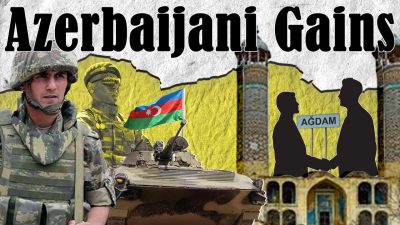Video: Azerbaijani Troops Enter First of Districts that Are Set to be Returned Under Karabakh Deal

Late on November 19, Azerbaijani troops started entering the district of Agdam in the Nagorno-Karabakh region. Agdam is one of the districts surrounding the Nagorno-Karabakh Autonomous Oblast of the Azerbaijan Soviet Socialist Republic that Azerbaijan lost to Armenian forces after the collapse of the USSR, as a result of the First Karabkah War.
On November 20, the district is set to be fully transfered to Azerbaijan under the peace deal reached by Baku and Yerevan to put an end to the Second Karabkah War earlier in November. An overwhelming majority of Armenians living in Agdam have already left the area. Over the past days, authorities of the self-proclaimed Nagorno-Karabakh Republic (also known as the Republic of Artsakh) were assisting in the evacuation. Many of the leaving Armenians were burning their homes in order to not allow the Azerbaijanis to seize them and use them in the future.
The next district, which is set to be transferred to Azerbaijani control, is Kalbajar. Originally, it had to be handed to Baku forces on November 15, but this development was rescheduled for November 25. The Armenians currently fleeing Kalbajar are burning their homes and properties that they cannot evacuate. If the control over Agdam and Kalbajar is transferred to Azerbaijan without major incidents, Lachin will become the next district that will face this fate.
Nonetheless, the Lachin corridor linking Armenia with Stepanakert and other Karabakh territories that will remain in the hands of the Armenians will be secured by the Russian peacekeeping force. Currently, the Russian military has 23 checkpoints in the conflict zone. The Lachin-Stepanakert road was reopened and over 1235 displaced civilians have returned to Stepanakert.
Contrary to the situation within districts that would be transferred to the Azerbaijani forces, Armenians do not flee the areas that will remain in the zone of responsibility of the Russians. Instead, many people that fled the conflict have opted to return their homes. Nonetheless, the local humanitarian crisis can hardly be avoided. According to the 2015 census, the population of the Nagorno-Karabakh Republic was about 151,000. The conflict reportedly displaced about a half of them, somewhere between 75,000-80,000. Even more people are now fleeing districts that are set to be transferred to Azerbaijan under the fear of violence, ethnic cleansing and other kinds of threats from the Azerbaijani forces and authorities. A part of the displaced people is now returning to Stepanakert and other nearby areas under Russian protection. However, even in the best case, the Armenian state will still have to deal with tens of thousands of displaced people in its territory. Yerevan already announced some financial help and economic support to these people, but the situation in Karabkah itself also requires attention. So far, the only side conducting humanitarian actions there has been Russia that created a special humanitarian center for this purpose.
The coming weeks will demonstrate the ability of the sides to compel each other to the reached ceasefire accords and, in the event of their implementation, a sufficient level of peace and security will finally be achieved in the region.
*
Note to readers: please click the share buttons above or below. Forward this article to your email lists. Crosspost on your blog site, internet forums. etc.
SUPPORT SOUTHFRONT:
PayPal: [email protected], http://southfront.org/donate/ or via: https://www.patreon.com/southfront

